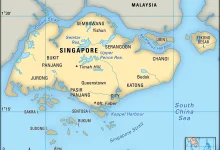Germany, officially known as the Federal Republic of Germany, is a country situated in Central Europe. It is renowned for its significant cultural heritage, economic prowess, and complex historical background. The total area of Germany is approximately 357,022 square kilometers (137,847 square miles), making it one of the larger countries in Europe.
Germany’s geographic dimensions place it at the heart of Europe, sharing borders with nine countries: Denmark to the north, Poland and the Czech Republic to the east, Austria and Switzerland to the south, and France, Luxembourg, Belgium, and the Netherlands to the west. This central location has historically made Germany a crucial player in European politics, trade, and culture.
The country’s topography is diverse, featuring a range of landscapes that contribute to its varied climate and ecological zones. The northern part of Germany is characterized by flat plains and the North German Plain, which extends to the North Sea and the Baltic Sea. This region is relatively low-lying, with an average elevation of about 50 meters above sea level. It includes important cities such as Hamburg and Bremen, which are major ports and economic hubs.
As one moves southward, the landscape becomes more varied and mountainous. The central part of Germany is dominated by the hilly terrain of the German Mittelgebirge, which includes several mountain ranges such as the Harz, the Erzgebirge, and the Taunus. These ranges contribute to the region’s picturesque landscapes and have historically been significant for their natural resources and strategic importance.
The southern part of Germany is home to the Alps, one of the most prominent mountain ranges in Europe. The Bavarian Alps, located in Bavaria, present some of the highest elevations in Germany, with the Zugspitze being the highest peak at 2,962 meters (9,718 feet). This mountainous region is known for its stunning scenery, outdoor recreational opportunities, and its influence on the climate, which can be markedly different from that of the northern plains.
Germany’s climate is influenced by its geographic diversity. The northern regions experience a temperate maritime climate, with moderate temperatures and high precipitation throughout the year. In contrast, the southern regions, particularly those influenced by the Alps, have a more continental climate with colder winters and warmer summers. This variation in climate affects the country’s agricultural practices, biodiversity, and overall lifestyle.
The administrative divisions of Germany also reflect its geographical diversity. The country is divided into 16 federal states, known as Bundesländer, each with its own unique cultural and geographical characteristics. These states are further divided into administrative districts and municipalities, which manage local governance and services.
Berlin, the capital city of Germany, is located in the northeastern part of the country. As one of the largest and most influential cities in Europe, Berlin serves as the political, cultural, and economic center of Germany. The city’s historical significance is profound, having been the epicenter of numerous historical events, including the division and reunification of Germany during the Cold War.
Other major cities in Germany include Munich, which is located in the south, known for its rich cultural heritage and vibrant economy, particularly in the fields of technology and automotive industries; Frankfurt, a global financial hub situated in the central-western part of the country; and Hamburg, a major port city in the north with a significant role in international trade and commerce.
Germany’s geographic location and size have played a significant role in shaping its history and development. The country’s position at the crossroads of various European cultures and its extensive border with multiple nations have influenced its political, economic, and social dynamics. The size of Germany also allows for a rich variety of landscapes and climates, contributing to its diverse cultural and natural heritage.
In summary, Germany’s total area of approximately 357,022 square kilometers encompasses a wide range of geographical features, from flat plains in the north to mountainous regions in the south. This diversity in topography and climate contributes to the country’s rich cultural and historical landscape, making Germany a central player in European and global affairs. The country’s geographical dimensions not only define its physical characteristics but also play a crucial role in its economic, political, and cultural identity.

